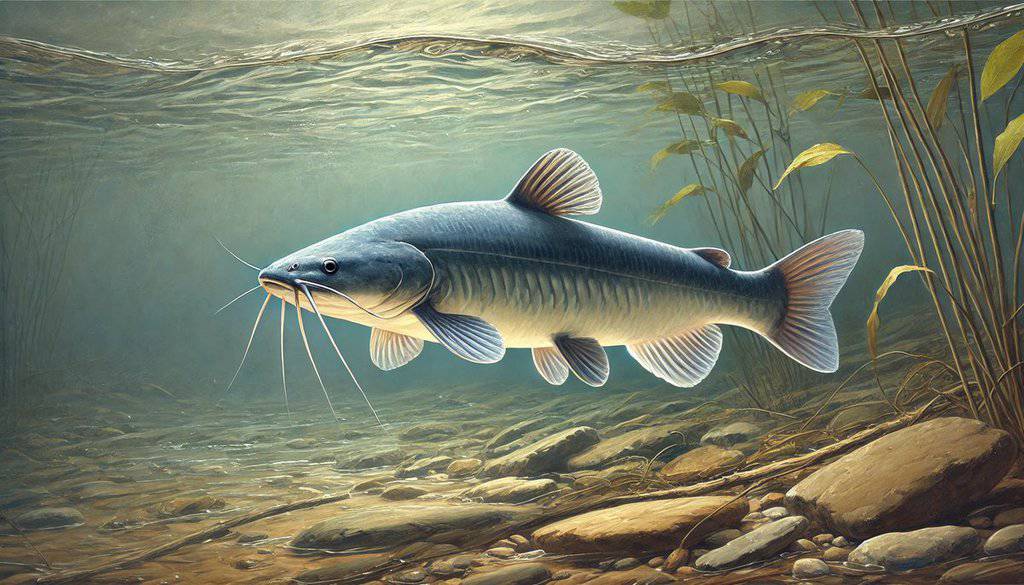Channel Catfish is a popular species for aquaponics systems due to its resilience, fast growth rate, and adaptability. Native to North America, this species has gained widespread interest in aquaculture and aquaponics for its excellent food quality and ease of management[1][5].
Natural Habitat and Behavior
Origin and native environment: Channel Catfish are naturally found in rivers, lakes, and ponds across North America[4].
Natural behavior in the wild: They are bottom-dwelling fish that prefer slow-moving waters and are known for their opportunistic feeding habits[4].
Temperament: In aquaponics systems, Channel Catfish are generally docile but can become territorial as they grow larger[1].
Compatibility: They can be kept with other non-aggressive fish species of similar size, but it’s best to avoid mixing them with smaller fish that could become prey[1].
Water Requirements
Temperature Range:
- Ideal temperature: 24-30°C (75-86°F)
- Survival range: 0-38°C (32-100°F)[4]
pH Level:
- Recommended range: 6.5-7.5 for optimal health and plant growth[1][2]
Water hardness: Channel Catfish are adaptable to various water hardness levels.
Oxygen Levels:
- Ideal dissolved oxygen levels should be maintained above 5 mg/L
- Channel Catfish can tolerate lower oxygen levels better than many other fish species[1]
Ammonia/Nitrate Sensitivity:
- Channel Catfish are relatively tolerant of higher ammonia levels, but it’s crucial to maintain ammonia below 1.0 ppm (1 mg/L) for optimal health[1]
- Nitrate levels should be kept below 140 ppm to avoid harm to both fish and plants[2]
Tank or Pond Setup
Tank/Pond Size Requirements:
- A reasonable fish density for small farms is one pound of fish per cubic foot of aquaculture tank space (about 7.5 gallons)[1]
Filtration & Aeration:
- Adequate filtration is crucial, especially for higher fish densities
- A separate biofilter for nitrifying bacteria is recommended[1]
Lighting Considerations: Channel Catfish prefer dimly lit environments, mimicking their natural habitat.
Tank Decorations/Substrate: Provide hiding spots and structures that mimic their natural environment, such as PVC pipes or plant pots.
Feeding Requirements
Diet:
- Channel Catfish are omnivorous and will accept a variety of commercial fish feeds
- A high-protein diet (32-35% crude protein) is recommended for optimal growth[3]
Feeding Techniques:
- Feed once or twice daily
- Adjust feeding based on water temperature and fish size[3]
Growth and Reproduction
Growth Rate:
- Channel Catfish can grow to 1-2 pounds in 18-36 months from egg to food-size[3]
Breeding Behavior:
- Spawning begins when water temperatures rise above 21°C (70°F)
- Broodfish should be at least 3 years old and weigh at least 1.4 kg (3 pounds) for reliable spawning[3]
Care of Fry:
- Fry require frequent feeding (6-12 times a day) with finely ground feed for good survival and growth[3]
Harvesting & Culinary Considerations
Growth to Harvest:
- Typically harvested at 1-2 pounds, which takes about 18-36 months from egg[3]
Culinary Uses: Channel Catfish have a mild, sweet flavor and are versatile in various culinary applications.
Pros and Cons
- Resilient and adaptable to various water conditions
- Fast growth rate
- Efficient feed conversion
- Require larger system sizes due to their growth potential
- May need separate biofilters for optimal performance in high-density systems
- Will eat any fish that fits in its mouth
Overall Suitability: Channel Catfish are suitable for both beginners and experienced aquaponics practitioners, especially those interested in food production.
Common Health Issues and Solutions
Potential Diseases: Channel Catfish can be susceptible to various bacterial and parasitic infections common in aquaculture.
Signs of Health Issues: Look for changes in feeding behavior, abnormal swimming patterns, or visible lesions.
Treatment Recommendations: Maintain good water quality and consider salt treatments for minor issues. Consult a fish health specialist for serious problems.
Maintenance Tips for Long-Term Health
Maintenance Frequency:
- Regular monitoring of water quality parameters is crucial
- Perform water tests at least weekly, more frequently in high-density systems
System checks:
- Monitor ammonia, nitrite, nitrate, pH, and dissolved oxygen levels regularly
- Maintain proper filtration and ensure adequate water circulation
Handling Practices:
- Minimize handling to reduce stress
- Use nets with fine mesh to avoid damaging the fish’s protective slime coat
Closing Thoughts
Channel Catfish are an excellent choice for aquaponics systems due to their hardiness, fast growth, and adaptability. They are particularly suitable for those interested in food production and can thrive in well-managed systems. However, their potential to grow large necessitates careful planning of system size and stocking densities.
More fish species for aquaponics
External sources:
[1] https://edis.ifas.ufl.edu/publication/HS1252
[2] https://extension.okstate.edu/fact-sheets/nitrification-and-maintenance-in-media-bed-aquaponics.html
[3] http://extension.msstate.edu/content/production-process-for-channel-catfish
[4] https://link.springer.com/article/10.1007/s10530-021-02459-x
[5] https://liveaquaponics.com/blogs/news/why-channel-cats-make-a-good-starter-fish
[6] https://www.aquaponiclynx.com/channel-catfish-2
[7] https://www.sciencedirect.com/science/article/abs/pii/S0044848622004458
[8] https://aquaponics-system.com/fish/channel-catfish-for-aquaponics/
[9] https://horticultureadvice.com/how-to-raise-catfish-in-aquaponics/
[10] https://gogreenaquaponics.com/blogs/news/tips-for-transitioning-fingerlings-to-your-aquaponic-system

